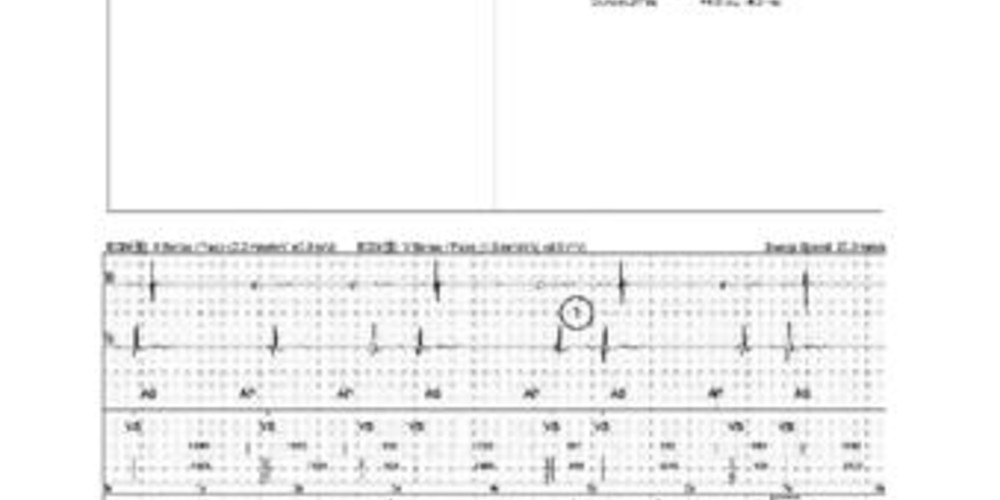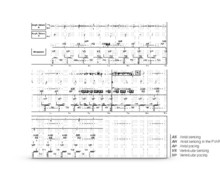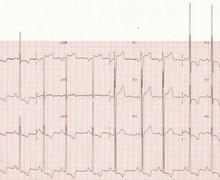shocks for ventricular fibrillation
Tracing
Manufacturer Abbott
Device ICD
Field Therapy
N° 27
Patient
This 28-year-old man presenting with hypertrophic cardiomyopathy, a family history of sudden death, episodes of non-sustained ventricular tachycardia (VT) and a 33-mm thick septum, received an Atlas dual chamber ICD and complained of syncope and a perception of electrical shock.
Main programmed parameters
- Single VF zone at 207 bpm
- 12 cycles in the VF zone were needed for the diagnosis
- Sensitivity programmed at 0.2 mV
- Shocks programming: first 15-J shock, followed by five 36-J shocks
- AAI episode pacing mode at 60 bpm; DDI post-shock pacing mode at 60 bpm

Graph and trace
Tracing
- Atrial paced, ventricular sensed rhythm; ventricular bigeminy with apparently present retrograde conduction and fixed VES – atrial sensed interval;
- Identical sequence (spontaneous ventricular rhythm and VES, evolving toward VF);
- Undersensing of low-amplitude ventricular EGM preceded by higher amplitude ventricular events, and alternans of VS, unclassified and F cycles;
- AAI episode pacing mode;
- VF detected after 12 F, followed by onset of capacitors charge;
- Undersensing of ventricular EGM during charge;
- End of charge;
- Delivery of 15-J shock on the second short cycle after the end of charge;
- Blanking for 1 sec after the shock;
- Unsuccessful shock and persistence of VF;
- Long series of undersensed EGM;
- Redetection of VF after 6 F classified cycles and re-charge of the capacitors;
- Persistence of undersensing;
- End of charge;
- After a 9.4 sec charge, delivery of 36 J, the strongest shock available from this device;
- Successful shock at the ventricular level, termination of VF and induction of AF;
- Restoration of sinus rhythm diagnosed by the device (5 VS) and switch to DDI post-shock pacing mode.
Other articles that may be of interest to you






At the end of the ICD implantation procedure, this young patient underwent induction of 2 episodes of VF, each successfully terminated by 15-J shocks, which explains the programming of the first shock amplitude. The tracing shows a relatively short charge time and the delivery of a first shock just over 6 sec after the onset of arrhythmia, at which time the patient was conscious. A 15-J first shock strength might be programmed with a view to abbreviate the overall duration of therapy, thereby preventing some patients to loose consciousness. The ineffectiveness of this 15-J shock highlights the probabilistic nature of the outcome of defibrillator shocks, and the low correlation between outcomes observed in the laboratory versus actual clinical results. While it was successful, the second, highest energy shock, was delivered >20 sec after the onset of arrhythmia and after a 9-sec charge time, explaining the complaint of syncope offered by the patient. This shock was arrhythmogenic in the atrium, as it was probably delivered during the atrial vulnerable period (shock synchronized to the R not the A wave). The tracing shows that the shock occurred shortly after atrial sensing.
The programming of the first shock energy in the VF zone is a compromise: a less than maximum energy shock might terminate VF after a short charge time; however, should it be unsuccessful, the second shock will be delivered after a long overall duration of VF. The programming of an immediately high energy is more likely to terminate VF, though at the cost of a longer initial charge time.